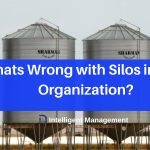It’s time for companies to update their knowledge and approach to business–what may have worked before is inadequate for the complexity all organizations face today. Our new series focuses on what companies need to embrace today to succeed and scale up. It is based on our new book in the works ‘From Silos to Network: […]
How to Manage your Organization as a Complex System
The Intelligent Management team is coming out with a new book to be published by Springer! It’s called ‘From Silos to Network: A New Kind of Science for Management’. We’ll be highlighting some of the content in the coming months. Today’s post is by Dr. Giovanni Siepe. Over the last 25 years there has been […]
Our Reality is Systemic – Time for Decision Makers to Understand the Implications
Today’s post ‘Our Reality is Systemic’ is by Dr. Domenico Lepore. It is an excerpt adapted from ‘Sechel: Logic, Language and Tools to Manage Any Organization as a Network‘ that is even more relevant today than when it was written during the global financial crisis. Our reality is systemic. As communication becomes more instantaneous, we are […]
Connect and Orient Your Entire Company Towards the Goal
Everything has changed. Things that were unthinkable not so long ago are coming to pass. And change is accelerating. If that’s the case, how can it make sense to keep on running and shaping organizations the way we did twenty years ago? This is an ostrich solution – putting our heads in the sand, doing […]
Beyond Continuous Improvement: Deming and Goldratt together
Why are so many companies being managed the same way as ten years ago, and with the same kind of organizational structure? It’s hardly surprising that there are a myriad of challenges when it’s clear to everyone that our reality has moved on, even if we haven’t. Trying to succeed with the same old recipes for […]
Confused about the Theory of Constraints? Don’t be!
A lot of confusion has arisen about the Theory of Constraints (TOC) and people publish the strangest things about it. Just this week, an entrepreneur in the USA is quoted as saying that his company “applies the theory of constraints to help identify the most pressing factors that stand in the way of achieving a […]
Why We Need Intelligent Management from Humans More than Ever
The Intelligent Management team is coming up for air after just submitting our completed manuscript to Springer! They will publish it this year in their SpringerBriefs in Complexity Series. It’s a short book but it packs a huge punch, revealing the science behind the Theory of Constraints in the way we apply it to manage an entire […]
Why Complexity Impacts Your Organization
It’s a new year and this month the Intelligent Management team are completing a new book! We are particularly honoured to be publishing something again with Springer, this time as part of their SpringerBriefs in Complexity Series. While our new book will appeal to those interested in the most scientific and mathematical aspects of managing […]
Continuous Learning is a Must for Organizations Today – A Systemic Approach Part 18
External reality continues to change at a hectic pace and we still have to guarantee that our organization is working properly and achieving its goal. This means we have to ensure a mechanism is in place that allows us to generate and update the knowledge we need in order to manage our system. A systemic […]
Why HR Is So Much More than a Department – A Systemic Approach Part 17
To be economically sustainable, a company must be designed for speed of flow. When we build an organization taking into consideration its constraint, we have a focus point or leverage point that allows us to do so much more with all the resources available towards a common goal. Without this advantage, any organization inevitably wastes […]














